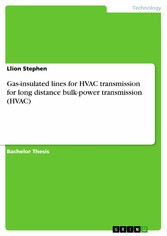Gas-insulated lines for HVAC transmission for long distance bulk-power transmission (HVAC)
von: Llion Stephen
GRIN Verlag , 2018
ISBN: 9783668775046
, 89 Seiten
Format: PDF
Kopierschutz: frei
Preis: 36,99 EUR
eBook anfordern 
Mehr zum Inhalt

Gas-insulated lines for HVAC transmission for long distance bulk-power transmission (HVAC)
Bachelor Thesis from the year 2018 in the subject Engineering - Power Engineering, grade: 76, University of Manchester, course: Electrical and electronic engineering, language: English, abstract: Various converters, generators, and other high power facilities are situated several kilometres away from metropolitan areas. Thus, numerous renewable energy sources with an interconnection between the generation and transmission technology require an efficient and high capacity system which entails the implementation of gas-insulated lines. Gas-insulated lines (GIL) are a resourceful High Voltage (HV) transmission technology, which offers an alternative to traditional cables or overhead lines (OHL). Conventional cables are unable to provide adequate long-distance bulk power transmission as the ratings for voltage or useful power at the load aren't sufficient in proportion to the line length. OHL with a lattice tower is a typical transmission method on shore with submarine Cross-linked Polyethylene (XLPE) cables or GIL utilised underground in challenging areas due to their flexibility and functional characteristics. A 420/550 kV GIL representation comprising of a multiphase model and constant RLC values presents an adequate analysis of the system. Fundamentally, GIL offers encouraging results given the high-pressured insulation medium, skin effect and returning current. Furthermore, by utilising a common platform for the simulations, a fair comparison with various HV transmission alternatives is accomplished. Additionally, this investigation incorporates an overview of the overvoltage and recovery characteristics of the simulated GIL with an adequate power supply concerning the installation of a synchronous generator and wind turbine. This research examines the economic factors with a distinctive focus on substantial investments made into offshore wind farms and GIL functioning in High Voltage Alternating Current (HVAC). The cost for this particular technical solution may provide an alternative to High Voltage Direct Current (HVDC) networks with Voltage Source Converters (HVDC-VSC) and submarine XLPE cables. The price per generating hour accumulates over time which reflects the total costs. Ultimately, the cost per unit is related to the demand. Finally, the literature review includes technical data, background information and a verification process for the simulation results.









